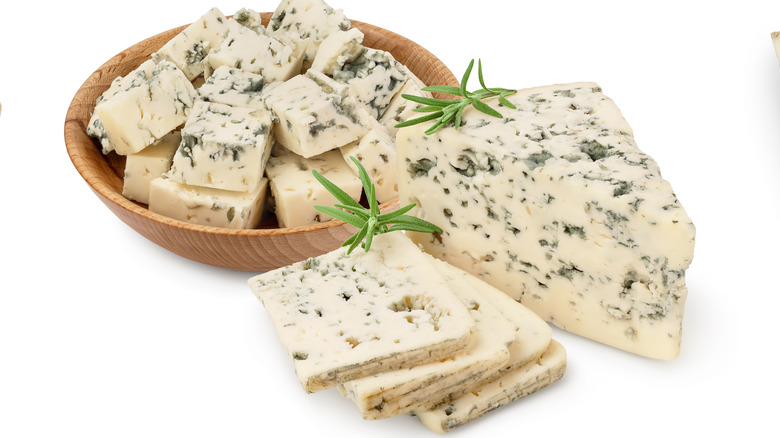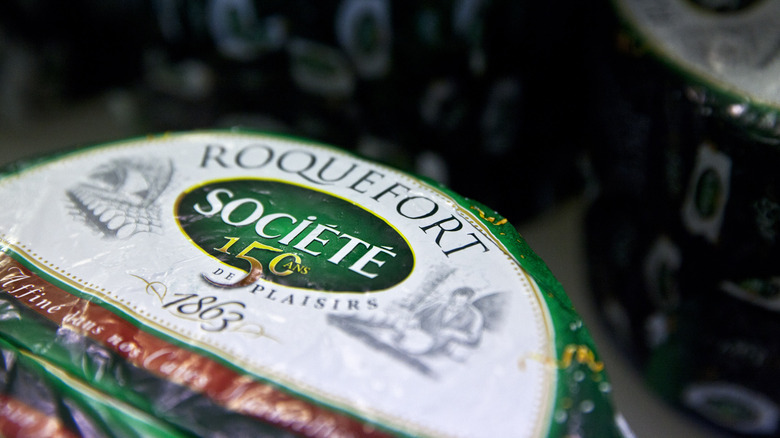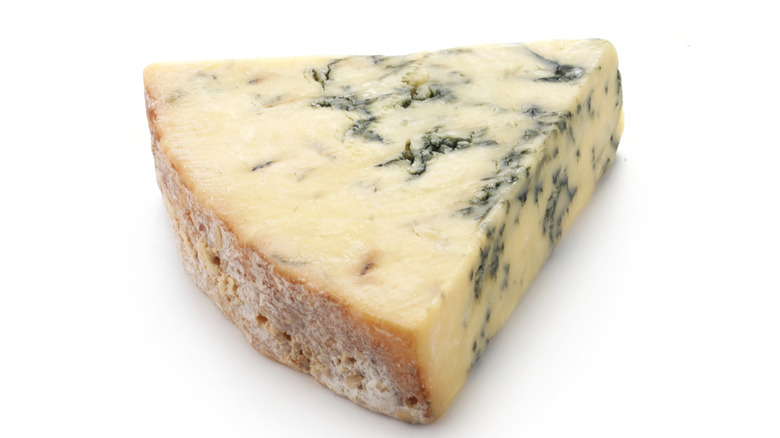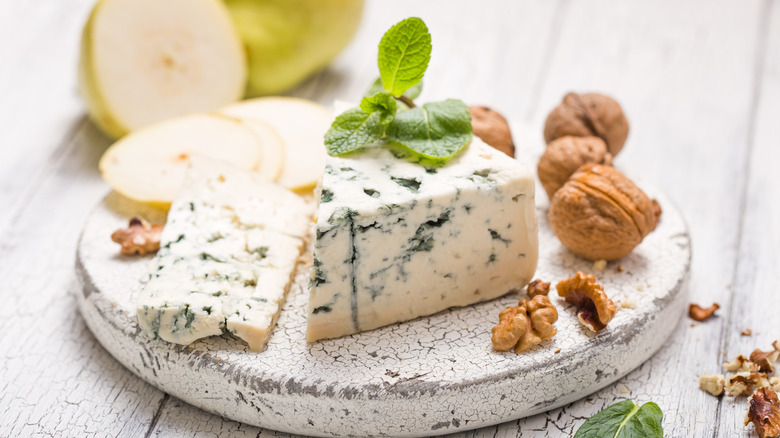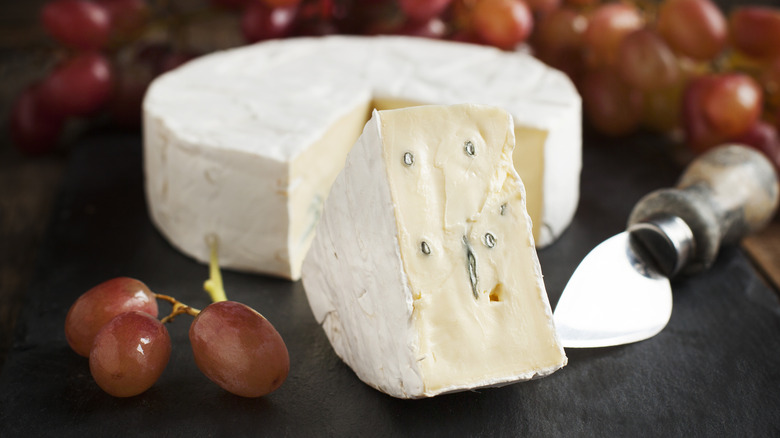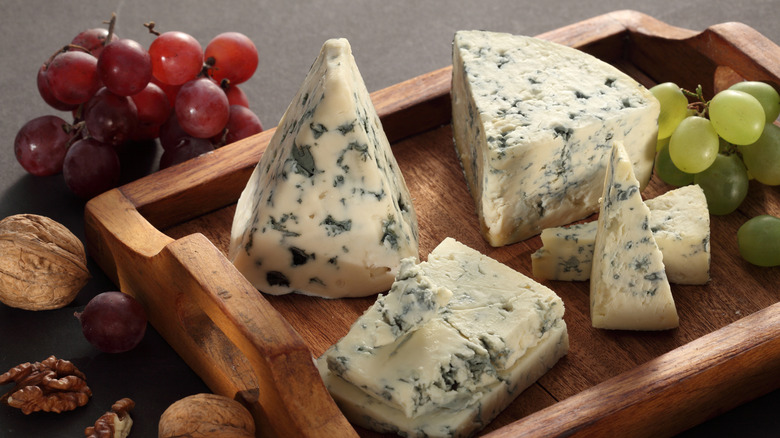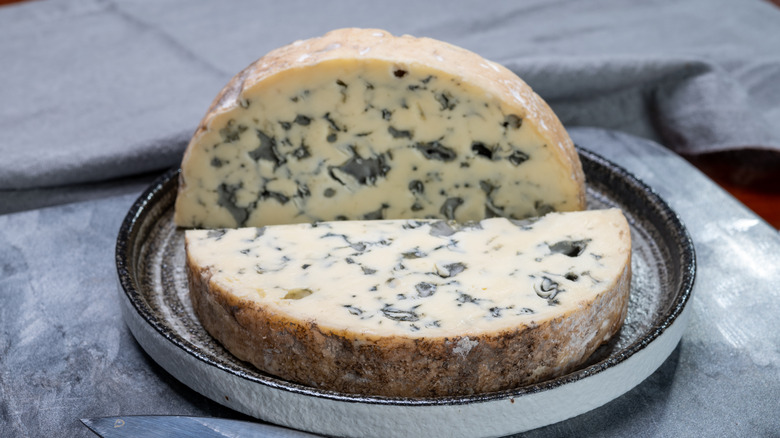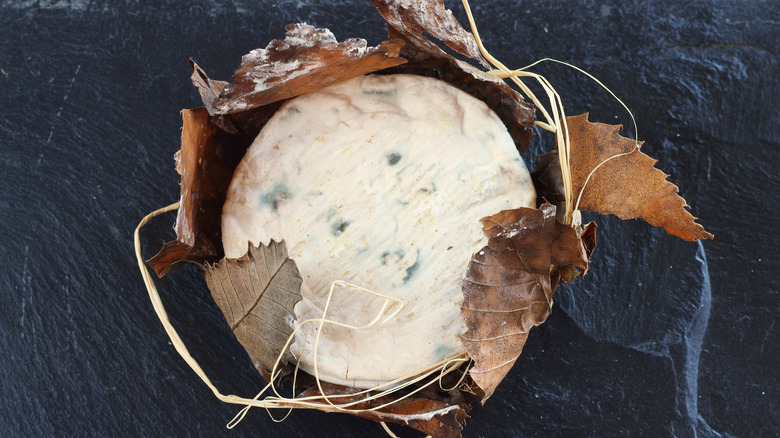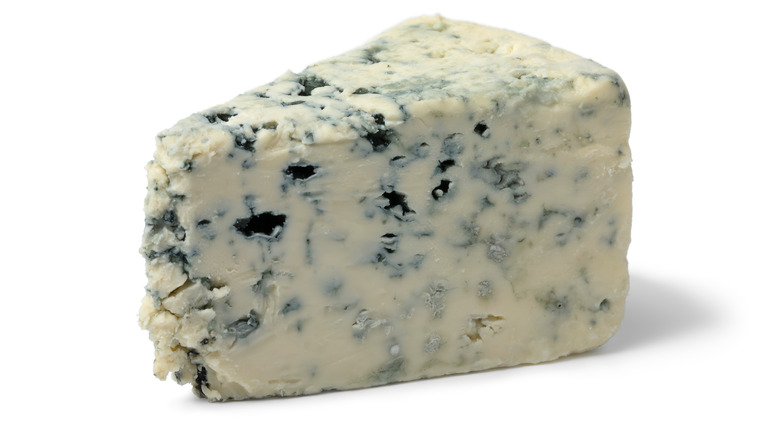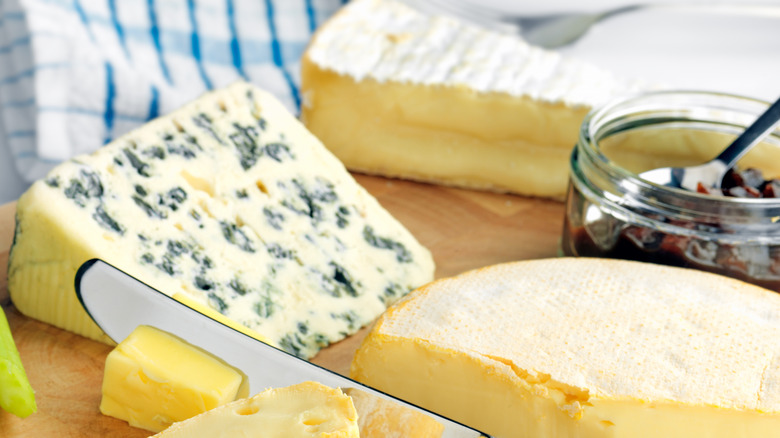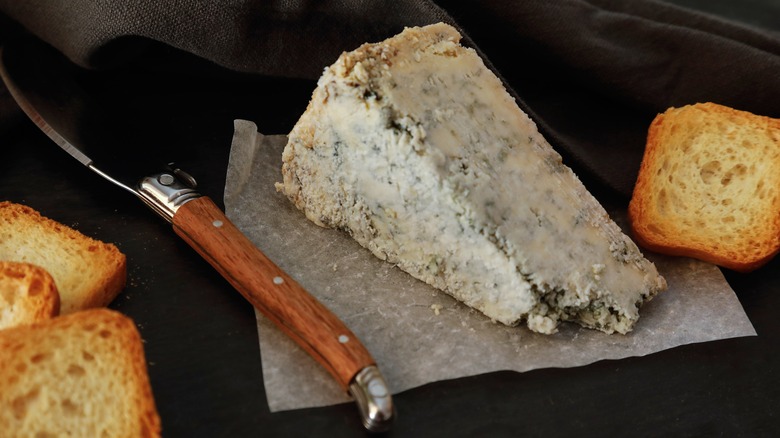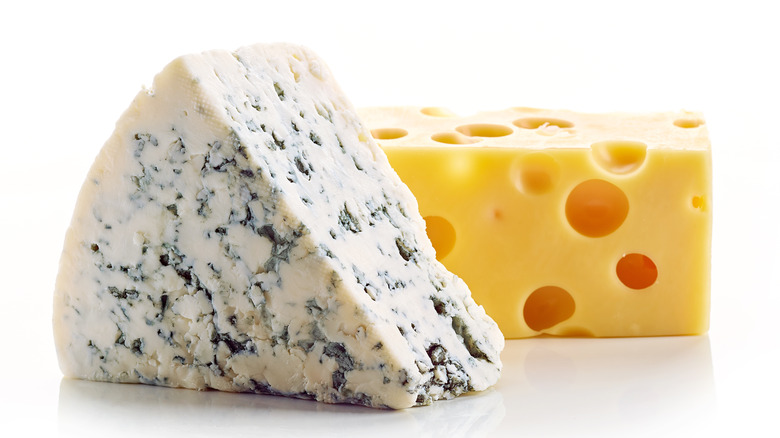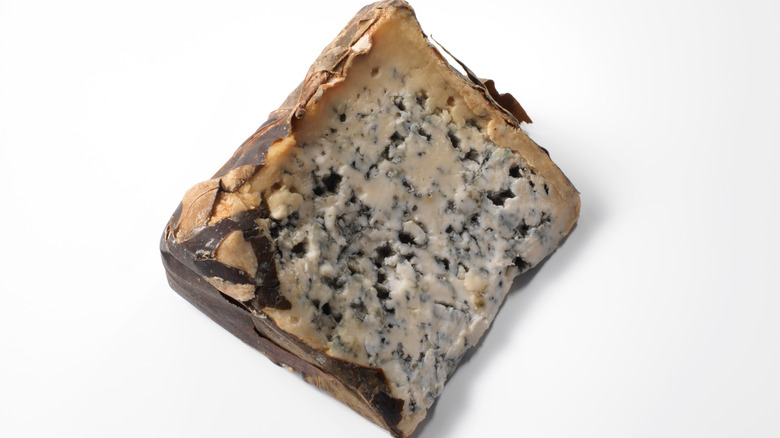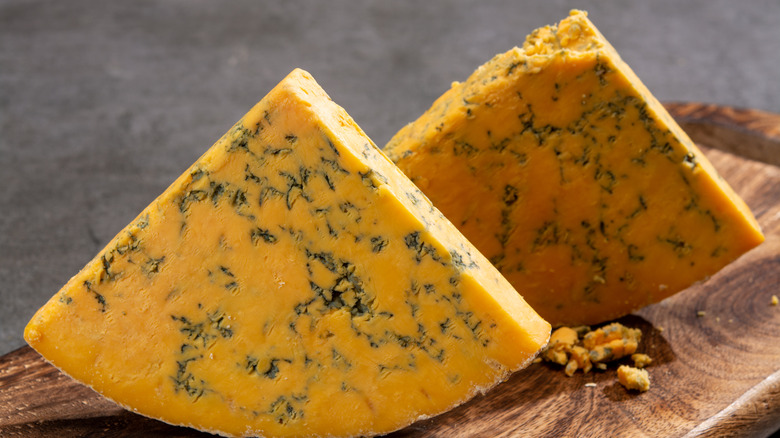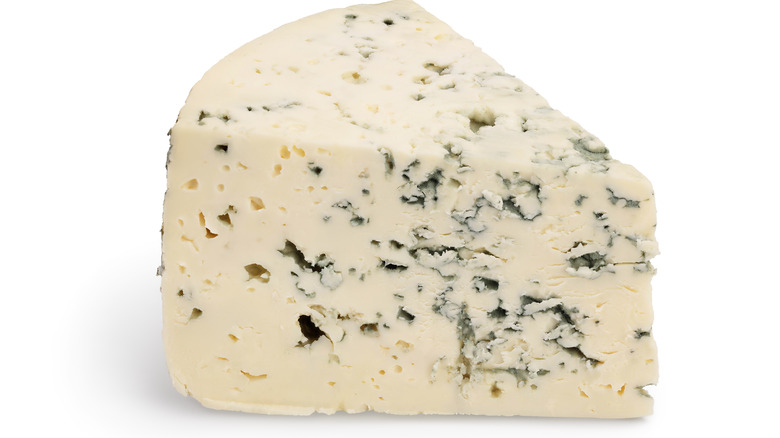14 Types Of Blue Cheese And What Makes Them Unique
Blue cheese can be a challenge for people. The salty — some would say "strong" — flavor is not for everyone and it can take getting used to, even for the most adventurous eaters. It also doesn't help that the visible streaks of blue — or sometimes green — in the cheese are in fact mold. As the Independent explains, this mold is perfectly harmless and comes from the same source as the antibiotic penicillin, so it doesn't produce the same toxins that other, less edible kinds of mold do.
Blue cheese also comes in a wide range of intensities and textures; from soft, creamy, and luscious to firm, crumbly, and intense. That means even if you think you don't like blue cheese, there's probably a variety suitable to your tastebuds.
Certain blue cheeses are considered some of the best in the world and they regularly win awards at major competitions. These famous names are known the world over. And the reputation they've built — some over the course of centuries — endures to this day.
So, let's dive in to the wonderful world of blue cheese, and what makes them unique, noteworthy, and delicious.
Roquefort
Roquefort is one of several cheeses that gets called "the King of Cheeses" (per Smithsonian Magazine), which changes based on who is making the claim. An Italian patriot is much more likely to declare Parmigiano-Reggiano as sovereign, but anyone with even a hint of Francophilia will go to bat for this pungent, sheep's milk cheese.
According to France Today, the legend behind Roquefort's origins involves a young shepherd in the southwest of France who spotted a beautiful shepherdess and left his lunch of fresh sheep milk curds and rye bread behind in a nearby damp cave. Upon returning a few days later, the boy discovered that his curds were streaked with bright green mold. Desperately hungry, he tried it anyway and discovered a delicious, sharp new flavor. Whether or not there is any truth to this, it is true that all Roquefort is still made in these caves to this day.
In the mid-2000s, Roquefort became a flashpoint between the United States and France as the outgoing Bush administration attempted to impose a huge 300% tariff on this cheese (via The Guardian). This was done in response to France banning the import of U.S. hormone-treated beef.
Traditional accompaniments to this rich cheese include rye bread, honey, quince paste, and especially the French dessert wine Sauternes. The rich, honeyed wine makes for a sensory overload when paired with this salty, ripe cheese and enthusiasts can't get enough.
Stilton
Another example of a "king," this traditional English variety dates back more than 300 years (per Nutrition Advance). It is rich in fat, which makes it especially creamy and tasty. Although it comes in a white variety, the blue veined type is by far the most well known.
Insider details how Stilton can only be made in a specific geographical area — but the town of Stilton falls outside this line and can no longer claim to produce this iconic cheese. The geography of this location played an important part in its early success since it was close enough to London that it was easily transported there to be sold at market.
In popular imagination, Stilton is inevitably linked to another English affection: Port wine. This Portuguese fortified wine is sweet, rich, and full of dried fruit flavors. These qualities make it a perfect match for the salty, powerful cheese. Although, as Stilton.org explains, the old fashioned practice of drenching a whole piece of it in Port should be avoided; you're better off sipping it separately if you want to appreciate their affinity for one another.
A spread of Stilton, ripe pears, walnuts, and plain water crackers would be enough to put a smile on any British aristocrat's face. Served with a glass of vintage Port, it would be hard to think of a better way to enjoy this contender for king.
Gorgonzola
Italy's beloved Gorgonzola cheese is very old, having originated all the way back in the 11th century in the town of the same name (via the Spruce Eats). Lombardy, in the northwest of the country, gave the world a gift when it discovered the creamy local cow's milk was delicious when inoculated with mold spores and allowed time to age and mature.
There are two main types of Gorgonzola: dolce (sweet), and piccante (spicy). Dolce is, as its name suggests, sweeter and milder. It is aged for less time and is actually the result of a different type of mold that produces a less pungent end result than the piccante (via Lucky Belly). This cheese is soft, creamy, and spreadable. It is perfect for a cheese board and is especially delicious when drizzled with honey; the floral sweetness goes great with the mild funk.
Piccante, on the other hand, is aged longer, so it is sharper as well as crumblier. This makes it great for things like salads, where the texture allows it to form distinct nuggets of cheese that can be sprinkled throughout and not smeared into a creamy mess. This type is also called "Mountain Gorgonzola" (per Culture Cheese Magazine).
Gorgonzola is a great cheese to serve in pasta sauce — whether in a blend with other cheeses or on its own — so its complex mature flavor can be appreciated without distractions.
Cambazola
A relative newcomer to the world of blue cheese, Cambazola has only been around since 1980 (via Cambozola). However, in that short time it has endeared itself to cheese lovers the world over. This soft, creamy cheese comes from southern Germany, where producers wanted to create a cheese with the decadent appeal of a soft Brie, but with the mature funkiness of a real blue cheese.
Although this is a rich, milky cheese, thanks to the maturation process, the Champignon Dairy (maker of Cambozola) says the finished product is lactose free. So it can be enjoyed by those who are less capable of processing this milk sugar, something that 68% of the world struggles with, according to U.S. Department of Health and Human Services.
The name is a mashup of the two cheeses: Camembert and Gorgonzola (per Gourmet Sleuth) — and it's a clue to the dual nature of this indulgent cheese. The producer adds cream to the milk used to make Cambozola which creates an even richer, creamier taste.
Cambozola is at home on a cheese plate, served with simple crackers so the beautiful texture can be appreciated alongside the mild "blue" flavor. A few grapes or some dried fruit complete a simple but delicious snack.
Bleu d'Auvergne
Named after the central French region of Auvergne from where it originates, this blue cheese is a connoisseur's choice. Sometimes called the "cow's milk Roquefort" thanks to the similarities between the two cheeses (via Cheese Culture Magazine), this is a true blue cheese lover's dream. It is struck through with many veins of the characteristic mold that adds such a pungent, salty bite.
French Moments details how this rich cheese must contain at least 50% fat, making for a creamy and delicious experience. Similar to many other blue cheeses, Bleu d'Auvergne is pierced over and over again with needles which allow the characteristic mold to penetrate to the very center of the wheel.
Although it is similar to Roquefort, Bleu d'Auvergne doesn't have quite the same pedigree. Cheese of the Month Club explains that it only came onto the market in the mid 20th century. When compared with other, much older cheeses, this is a relative newcomer. However, that shouldn't suggest the quality is deficient; the cheese is excellent.
Cheese-France recommends serving Bleu d'Auvergne as a snack before a meal, either on a piece of buttered bread or even on a slice of apple — the sweetness can help balance the salty tang. Like lots of cheeses, you will get the most out of it if you serve at room temperature rather than right out of the fridge.
Fourme d'Ambert
One of the oldest cheeses in France, Fourme d'Ambert dates all the way back to Roman times (via East London Cheese Board). This means that makers of this ancient cheese have had plenty of time to perfect their work. The cheese has a slow-building intensity that doesn't smack you across the mouth like some other blues. Instead, the salty bite is tempered by the luscious, creamy texture — and before you know it, you've eaten the whole thing!
The name Fourme d'Ambert comes from the old Latin word for cheese. It refers to the round, cylindrical shape that this cheese typically comes in (per Cheese-France). This etymology is no surprise when you consider that the Latin-speaking Romans ruled France (which they called Gaul) at the time this cheese was invented.
The cheese also comes from Auvergne in France. The area is relatively secluded from the rest of France thanks to the mountains that cover most of the region. And Auvergne still benefits from its mountainous terrain to pasture the cattle that make the milk for its famous cheese.
Similarly to other blue cheeses, Bleu d'Auvergne is a perfect pairing with a sweet wine. It is also a traditional choice for making a blue cheese soufflé.
Rogue River Blue
Although Europe produces a great many world-famous cheeses, the United States also has its share of artisans that make top notch stuff. One particularly noteworthy example is the Rogue Creamery from central Oregon. Their Rogue River Blue was named the best cheese in the world at the 2019 World Cheese Awards (via Oregon Live). This marks the first time an American cheese has won the coveted prize.
According to Rogue Creamery's website, this special cheese is wrapped in wine grape leaves that have been soaked in pear spirits. This added dimension of flavor makes for a complex cheese with notes of fruitiness as well as astringency from the grape leaves. Like many aged cheeses, this blue develops crystals inside that connoisseurs love. The company advises enjoying Rogue River Blue on its own or with a simple fruit accompaniment.
Thanks to the notoriety that comes from winning such a high profile competition, Rogue Creamery has seen incredible demand for this very special cheese. However, as Cheese Professor explains, this is a strictly seasonal product. The milk is harvested in the Fall, when it is extra sweet and complex tasting, and all of the grape leaves with which the cheese is wrapped come from nearby organic vineyards. Talk about a type of blue cheese that's truly unique! Extraordinary stuff!
Danish Blue
Coming unsurprisingly from Denmark, Danish Blue Cheese is as close to "standard" blue cheese as you are likely to find. It sits right in the middle in terms of pungency and is neither crumbly nor creamy, but somewhere in between. According to Castello, which makes the cheese, "The flavors are pungent and sharp, with a creamy and smooth texture on par with many soft cheeses."
Also known as Danablu, this cheese is great for serving as a snack or when crumbled into a salad (per Cheese House). Thanks to its "in between" character it can assume just about any role you may need. As Cook's Illustrated explains, Danish Blue is made with homogenized milk, which creates a very white background and a particularly creamy mouthfeel. This process also means that the "blue" flavor is in the front seat, while the more neutral, milky flavors present in some other kinds of blue cheese plays a secondary role.
Like other blue cheeses, Danablu is a particularly good source of calcium (via WebMD). While this doesn't make it a health food, it should perhaps alleviate some of the guilt that comes with eating a food that's about 25% fat. That and how tasty it is.
Saint Agur
Yet another blue that comes from the Auvergne region of France, Saint Agur is a soft, creamy, buttery cheese that is a perfect "beginner's blue." Its supple texture and mild saltiness mean it can serve as an introduction to the bite associated with blue cheese without too much intimidation that types such as Roquefort have. Ripened for only 60 days (per Cheese.com), this cheese doesn't have time to get as funky as some of the other blue cheeses.
Saint Agur is a younger cheese, having been invented by the French dairy giant Bongrain in 1988 (via SF Gate). It has taken off in popularity since then, however, as cheese lovers lean in to having the best of both worlds — the complexity and funkiness of a blue cheese as well as the melting creaminess of a softer option. With a butterfat content of around 60%, this is categorized as double cream cheese (per Cheese Professor), so what's not to like?
This winning combination of approachability with a tinge of adventure has made Saint Agur the most popular blue cheese sold in the U.K. (via The Cheese Lover). The wheels of cheese are made into hexagonal shapes that make it particularly easy to cut it into appropriate wedges.
Because it is so creamy, this cheese goes particularly well with fruit and other sweet things. A smear of Saint Agur and fig jam spread on a cracker is like fireworks in your mouth.
Cabrales
Cabrales is a unique blue cheese in that, "It is made with cow's milk or with goat and sheep's milk, which is more highly valued," (per Spain-Recipes). It comes from the Asturias region of northern Spain. Here, the mild climate and moderating influence of the Atlantic Ocean make this part of what is called "green Spain." This section of the country lies in the temperate north and has a much gentler climate than the arid center (via Galicia Guide).
Cabrales is known for having a large proportion of its inside streaked with the blue cheese mold, which makes for a particularly pungent cheese (per Fine Cooking.) This special cheese is produced in relatively limited amounts because it is all done on smaller, individual farms. The individual producers tend to favor traditional, rather than modern, methods of productions (via Taste Atlas). That makes this a true artisanal cheese, something to consider when searching for something different at the cheese counter.
According to Fascinating Spain, this is another cheese with a dubious backstory that involves a shepherd accidentally leaving some fresh milk in a cave and coming back only to discover a new tasty treat in its place. Legends aside, this cheese is, in fact, aged in local caves, where the humidity is perfect for the maturation of this spicy Spanish delicacy.
Maytag Blue
Another American domestic variety of cheese, Maytag Blue hails from Newton, Iowa where the original was produced in 1941. This cheese is made from cow's milk that is homogenized, but not pasteurized. Maytag Blue makes for an extra creamy, rich eating experience (per Delighted Cooking).
According to Maytag Dairy Farms, this cheese was an effort to recreate the great French Roquefort in the United States. To that end, the inventor, Frederick L. Maytag II, took the finest milk he could find (from his family's own herd, in fact) and inoculated it with the same mold strain used in Roquefort. He also decided to emulate the producers of Roquefort in one other way: He aged the finished wheels of cheese in local caves, hoping to emulate the conditions that make Roquefort such a well-respected cheese the world over.
Thanks to this focus on quality, Maytag Blue does not get released in large amounts. Instead, the dairy makes a small quantity of premium product (via Cheese.com). This tradition started with the first wheel of cheese and continues to this day; a recent addition of a Reserve Label proves the endurance (and fondness) to thoughtfully-made cheese that Maytag has become known for (per Perishable News).
Valdeon
Similar to Cabrales, Valdeon is a northern Spanish cheese with an international reputation. Valdeon is known for being spicy and very "blue" tasting, even though it actually has less mold development than Cabrales, thanks to the lesser humidity in the caves where it is aged (via Cheese Culture Magazine). The traditional method of aging this cheese calls for wrapping the wheels in sycamore leaves, which are not only decorative but add a subtle flavor all their own.
According to Forever Cheese, Valdeon is an offshoot of Cabrales that was given its own identity when regulators decided that only cheese made in the town of the same name could be called Cabrales. Since then, Valdeon has developed its own reputation as a high quality, premium blue cheese.
Valdeon comes from the town of Leon in northeast Spain. As Chef's Mandala explains, this is a very old settlement, having its origins all the way back in 1 B.C. and the Romans who conquered the area. This history includes the traditions of cheese making that makes use of the nearby caves which provide a perfect environment for aging fine cheese.
The cheese, thanks to its pronounced flavor and piquant taste, is best paired with something a little sweet. A perfect example would be the quince paste that Spanish Food Guide explains in detail — the concentrated sweetness is perfect with the salty bite of the cheese.
Shropshire Blue
Shropshire Blue is a distinctive orange colored blue cheese originating in the U.K. According to New England Cheese Making Supply Co., this cheese was first produced in Scotland, but as its popularity grew, other makers tried their hand at this variety as well. Now producers in England make Shropshire Blue in the same region that the legendary Stilton is made. Confusingly, this cheese is not made in the English town of the same name.
Cheese.com explains that this cheese resembles a cross between Stilton and another famous English cheese: Cheshire. The orange color of both Cheshire and Shropshire comes from the natural dye of annatto. This bright orange hue, matched with the veins of blue makes for a very unique presentation. If you want to pick out a perfect specimen of Shropshire Blue, make sure there is no sign of drying out or cracking — because that means the cheese is too old and would be unpleasantly strong (via Gourmet Sleuth).
This is also a particularly well-regarded cheese. In 2016 it won "Supreme Champion" at The British Cheese Awards as well as "Best English Cheese" and "Best Blue Cheese" (per East London Cheese Board). This reputation is more than justified by the salty, delicious flavor of this beautiful cheese.
Just like Stilton, Shropshire Blue is best when served with a glass of Port.
Buttermilk Blue
Roth Buttermilk Blue cheese is, despite the name, made from fresh cow's milk and is a great beginner's blue cheese. It does not have the (sometimes) harsh flavors of other varieties, and the relatively mellow flavor is perfect for serving on a cheese board (via Roth Cheese). The name comes from the pleasantly tangy taste that the cheese develops as it matures.
The Roth family who invented this cheese has their origins in Switzerland (per Cheese Culture Magazine). This international perspective has given them insight into how to make high quality, European-style cheeses that can also appeal to the American palate, which can sometimes be wary of cheese that's too pungent.
The company has come to represent a success story of the Wisconsin cheese industry. The abundant, high-quality milk available to the farmers in this Midwestern state provides the first step to a top-notch end product. This point is proved by the many accolades and awards won by the best Wisconsin cheese. In fact, in 2022 Roth scored two Best of Class wins at the World Championship Cheese Contest for one of its carefully crafted products (via Emmi Roth).
This means that Buttermilk Blue is an approachable entry point that was created by people who know their stuff and for whom cheese making is not only a way of life, but an entire family legacy.
